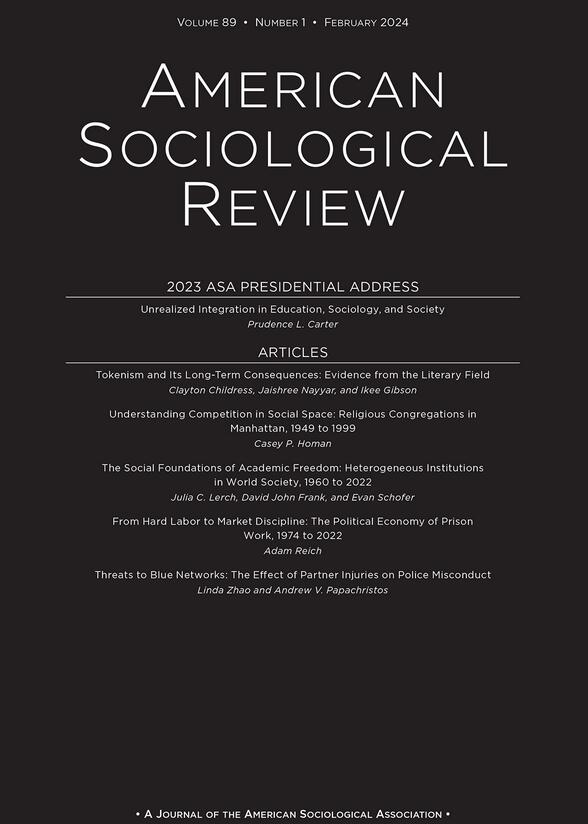从暴力中获得清晰?群体内部攻击与地位等级结构
IF 6.2
1区 社会学
Q1 SOCIOLOGY
引用次数: 0
摘要
地位等级制度是社会秩序的基本形式,构成了群体内部攻击等同伴互动。然而,这种互惠关系仍不清楚。群体内部的攻击性是加强还是削弱了地位等级制度?在什么条件下?为了回答这些问题,我分析了一个原始数据集,该数据集包含256个班和三个学期的8229名青少年的受害和定向友谊网络。通过等级三元组表征友谊提名的可能性来衡量地位等级的强度,我发现同伴攻击削弱了地位等级,时间序列表明结果不太可能用反向因果关系来解释。我的理论是,明确的地位等级制度是通过协调的尊重重新分配而产生的,而同伴的攻击主要是通过给旁观者共同的协调机会而产生的。然而,同伴的攻击往往是模棱两可的,旁观者会得出不一致的解释,破坏了他们给予尊重的方式,降低了地位区别的清晰度。其他分析证实,同伴攻击是否会加强或削弱地位等级取决于旁观者的一致看法。总之,这项研究证明了第三方旁观者的重要性及其一致解释互动的能力,同时为同伴攻击何时是自我限制或持续的提供了新的解释。本文章由计算机程序翻译,如有差异,请以英文原文为准。
Clarity from Violence? Intragroup Aggression and the Structure of Status Hierarchies
Status hierarchies are fundamental forms of social order that structure peer interactions like intragroup aggression. The reciprocal relationship, however, remains unclear. Does intragroup aggression strengthen, or weaken, status hierarchies? Under what conditions? To answer these questions, I analyze an original dataset containing victimization and directed friendship networks of 8,229 adolescents across 256 classes and three semesters. Measuring the strength of status hierarchies by how likely friendship nominations are characterized by hierarchical triads, I show that peer aggression weakens status hierarchies, and temporal sequences indicate the results are unlikely to be explained by reverse causality. I theorize that clear status hierarchies emerge through coordinated reallocations of esteem, and peer aggression engenders hierarchy primarily by giving onlookers shared opportunities to coordinate. Peer aggression, however, is frequently ambiguous, and onlookers arrive at inconsistent interpretations, fragmenting how they assign esteem and reducing the clarity of status distinctions. Additional analyses confirm that whether peer aggression strengthens or weakens status hierarchies depends on the consistent perceptions of onlookers. Taken together, this research demonstrates the significance of third-party onlookers and their ability to consistently interpret interactions, while offering new explanations for when peer aggression is self-limiting or persistent.
求助全文
通过发布文献求助,成功后即可免费获取论文全文。
去求助
来源期刊

American Sociological Review
SOCIOLOGY-
CiteScore
13.30
自引率
3.30%
发文量
35
期刊介绍:
The American Sociological Association (ASA) is a non-profit membership association established in 1905. Its mission is to advance sociology as a scientific discipline and profession that serves the public good. ASA is comprised of approximately 12,000 members including faculty members, researchers, practitioners, and students in the field of sociology. Roughly 20% of the members work in government, business, or non-profit organizations.
One of ASA's primary endeavors is the publication and dissemination of important sociological research. To this end, they founded the American Sociological Review (ASR) in 1936. ASR is the flagship journal of the association and publishes original works that are of general interest and contribute to the advancement of sociology. The journal seeks to publish new theoretical developments, research results that enhance our understanding of fundamental social processes, and significant methodological innovations. ASR welcomes submissions from all areas of sociology, placing an emphasis on exceptional quality.
Aside from ASR, ASA also publishes 14 professional journals and magazines. Additionally, they organize an annual meeting that attracts over 6,000 participants. ASA's membership consists of scholars, professionals, and students dedicated to the study and application of sociology in various domains of society.
 求助内容:
求助内容: 应助结果提醒方式:
应助结果提醒方式:


